|
Benevolent
and Protective Order of Elks
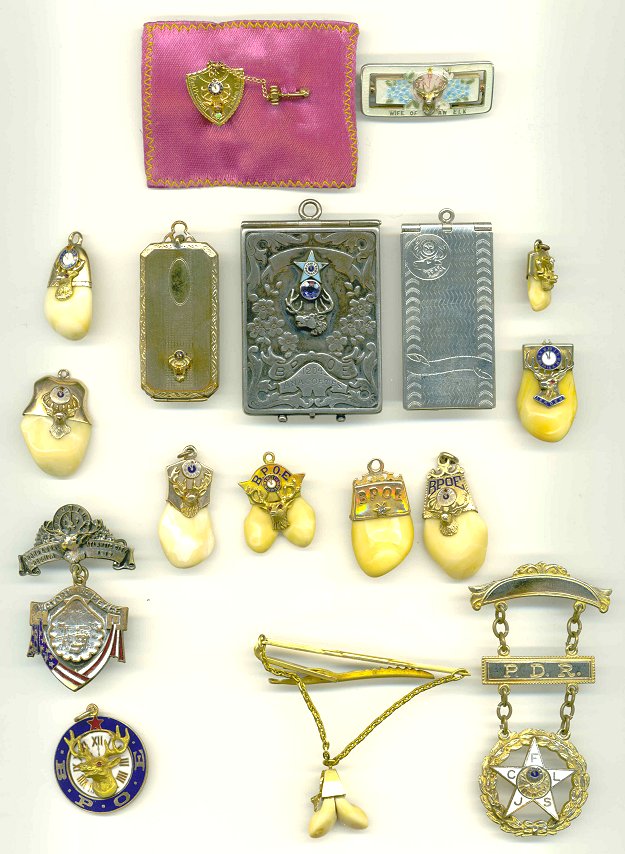
The most popular Elk piece is undoubtedly the gold mounted elk’s tooth which on
average commands $75-100 and more for larger and more elaborate pieces--all this in spite
of an enormous supply that has of yet shown no sign of diminishing. (Moose teeth, probably
ten times as rare, seldom fetch more than $20.)
The jewel with the star and wreath is from the
IBPOEW, a black Elks order.
The sterling receipt case is a fairly common
design but this one is set with a half carat sapphire which is not common. It was probably
a presentation piece for a Past Exalted Ruler.

The
Origins of the BPOE
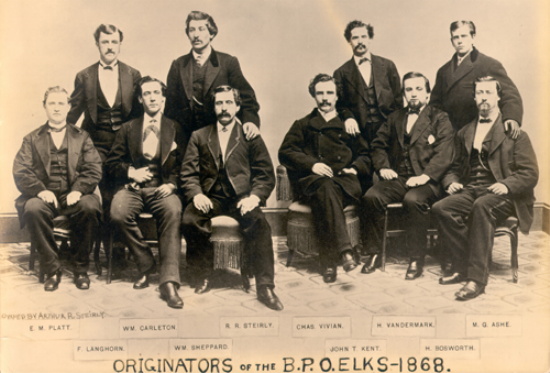
In New York City, a small group of actors and entertainers, wishing to continue
their social gatherings on Sundays, when New York's blue laws prevented the
opening of public establishments, began to meet regularly as the "Jolly Corks,"
a name derived from a bar trick introduced by the group's organizer. While the
meetings were held with regularity, apparently no form nor substance resulted,
except for the adoption of a toast to members of the group not in attendance.
Shortly before Christmas in 1867, only a few months after the fellows began to
meet, one of their number died, leaving his wife and children destitute.
This event gave rise to the notion that, in addition to good fellowship, the
Jolly Corks needed a more noble purpose in order to endure, and serving not only
their own in need, but others as well, would be appropriate. Two months later,
on February 16, 1868, with a statement of serious purpose, an impressive set of
rituals, a symbol of strength and majesty and such other elaborate trappings
that might be expected of a group of actors and musicians, the new fraternal
order was launched.

Why the
"Elks?"
Since its founding on February 16, 1868, the Benevolent and Protective Order of
Elks (BPOE) has been recognized by the noble creature that is the symbol of the
Order. The elk is a peaceful animal, but will rise in defense of its own in the
face of a threat. The majestic creature is fleet of foot and keen of perception.
A most fitting representation, the stately elk is, for a distinctively American,
intensely patriotic, family oriented organization subscribing to the cardinal
principles of Elkdom, "Charity, Justice, Brotherly Love and Fidelity."
The 15 Founders of the BPOE desired a readily identifiable creature of stature,
indigenous to America. Eight members voted to adopt the elk, seven favored the
buffalo.
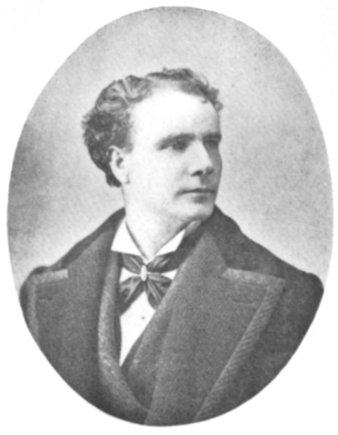
The main Founder of the Elks, Brother Charles Algernon Sidney Vivian,
an English-born actor, was a member of the British fraternity known as the Royal
Antediluvian Order of Buffaloes. Brother Vivian especially desired to see the
new Order adopt the title of "buffaloes," but the vote carried with the name of
"Elks."

Fraternal Traditions of the BPOE
The BPOE adopted several fraternal traditions similar to the Masonic Fraternity.
An altar, decorated with the Holy Bible, is found in the center of every Lodge
throughout Elkdom. Old Glory served as the altar's drapery until 1956, when it
was given its own distinct place of honor to the right of the altar. An "Exalted
Ruler" governs each Elks Lodge as the "Worshipful Master" does in a Masonic
Lodge.
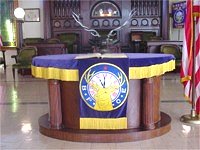
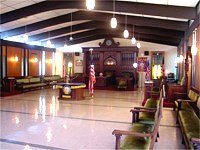
Elk Officers wear formal evening dress (tuxedos) during the Initiation Ritual
and other ceremonials of the Order. Since 1874, the Exalted Ruler and officers
of every Elks Lodge began wearing the new Elks regalia, composed of a purple
velvet collar with a small, fawn colored roll and a jewel with an Elk's head
with a gilt edge on the collar.
A "Tiler" guards the entrance of every Elks Lodge, and this officer prevents all
outsiders from entering a Lodge without proving themselves to be an Elk in good
standing.
The BPOE originally utilized a two-degree ritual; the second degree was
discontinued in 1890. In fact, the BPOE Grand Lodge has outlawed any side
degrees. The solemn and dignified BPOE Initiation Ritual of today is vastly
different from the Initiation performed within our Lodges in those early days,
with the early minutes of several Lodges, describing the now-solemn ritual in a
far different vein.
Early candidates found that a physician's certificate of examination was
necessary as a part of the joining process, and the male prospect had to be in
top condition to even be considered. Then, once the candidate had met that
criteria and was in the Lodge room, he was blindfolded, and instead of dimmed
lights and beautiful words, he was subjected to much horseplay. The minutes of
the Ashland Lodge No. 384 describe in detail of their candidates wearing shoes
with lead soles designed to make the wearer walk as though intoxicated.
The old Ritual Book spells out other trickery, with members agreeing with the
Exalted Ruler's declaration that the candidates be "shaved." Once this decision
was made, a "City Barber" appeared to the blindfolded candidates whereupon, with
a dull file simulating a straight razor, he literally scraped the faces of the
men to "shave" them. A few other jokes, all of which were contained in the
Ritual Book, described each ordeal in great detail, such as "walking on broken
glass," actually egg shells, and it even mentioned how to end the "horseplay"
session with real guns, loaded with blanks, being fired off behind the now-weary
and very confused new members.
In 1895, the Elks ceased the use of lambskin aprons in their initiatory work,
the password was eliminated in 1899, in 1902 the use of a badge was eliminated,
with the secret grip falling by the wayside in 1904 and the "Test Oath" was
removed in 1911. In 1952, candidates were no longer blindfolded prior to the
Initiation. 1995, women were admitted into the Order.

The
Eleven O'clock Toast
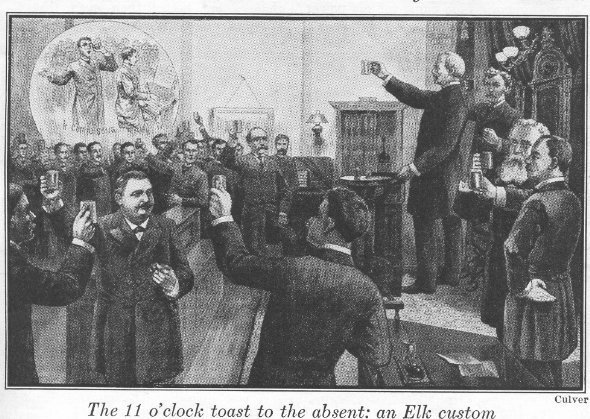
At every meeting of the BPOE, and every social function, when the hour of 11:00
p.m. tolls, the Lodge conducts a charming ceremonial known as the "Eleven
O'clock Toast." In fact, the clock tolling the eleventh hour is part of the BPOE
official emblem, and is directly behind the representation of an elk's head in
the emblem of the Order.
Regular meetings of Subordinate Lodges have always been held at night. In the
earlier days, they were usually held on Sunday nights and were concluded about
eleven o'clock. As the participants departed, the Brothers made inquiries about
the absent Brothers and expressed sympathetic interest in the causes of their
absence.
It soon became a custom for some member to propose a toast to the Brothers who
were not present. And in the course of time, this custom was quite generally
observed whenever a group of Elks were together at eleven o'clock. Eventually,
the Grand Lodge specifically provided for such a ceremonial to be observed
during Lodge sessions; and designated it as "The Eleven O'clock Toast." Under
this provision, whenever a Lodge was in session at that hour, the regular order
of business was suspended for a few moments while the Exalted Ruler recited the
beautiful ritual prescribed, concluded with the words: "To our absent Brothers."
Since women were permitted to join the Elks since 1995, the toast is now
pronounced as "To our absent Members."

"The Elk's Alphabet"
(Written on the Elks' Fiftieth
Anniversary)
By Bro. Raymond A. Browne
New York Lodge No. 1 BPOE
The "A" is for "Altar," where proudly repose
The Three Precious Symbols that ev'ry Elk knows.
The "B" is for "Brother, a word that we love;
It makes us all kin, does the term from Above.
The "C" is for "Charity, noblest of deeds;
It carries a blessing in each of its seeds.
The "D" is for "Discord" we never have known,
And "Duty," that bids us to take care of our own.
The "E" is for "Eleven," the hour of prayer,
When "Our Absent Brothers" our loving thoughts share.
The "F" is for "Fidelity," ne'er does it lag;
Just now it bids us to stand up for our Flag.
"The "G" stands for "God," the Omnipotent King,
Whose children we are, and whose praises we sing.
The "H" is for our "Home," where a welcome awaits,
The "Wandering Elk" who has come to our gates.
The "I" is for "Initiate," waiting the words,
That makes him an Elk, with a place in the herds.
The "J" is for "Justice," impartial and free,
Yet tempered with Mercy, as Justice should be.
The "K" is for "Knowledge," that thrills you and me,
That all the world honors the "B.P.O.E."
The "L" is for "Lodges," all over the land,
About fifteen hundred, and many more planned.
The "M" is for "Mem'ry," of each bygone prince
Who helped found our Order, just fifty years since.
The "N" is the "Nation" of which we're a part,
And love for it burns bright in ev'ry Elk's heart.
The "O" is for our "Order," and likewise our "Oath,"
As long as life last, we'll be faithful to both.
The "P" is our "Pockets," that we reach in, and quick,
To help the distressed, and the poor, and the sick.
The "Q" is the "Queens" of our hearts and our lives,
Our Mothers, and Sisters, our Sweethearts, and Wives.
The "R" is "religion," we know only ONE:
To do good to all, and do evil to none.
The "S" is the "Star" that looks down from above,
And sheds on our Altar the radiance of love.
The "T" is for "Time," with his scythe and his glass;
He bids us remember, "Do good as ye pass."
The "U" is the "Unknown," where are Brothers of old,
Found rest when the story of life was all told.
And "V" is the "Vision" that sometimes seems plain
Of that Other World where we'll meet them again.
The "W" the "Widows" who call not in vain;
We've helped them before, and we'll help them again.
"X" that's the "Xample" we set to the world,
Wherever the standard of Elkdom's unfurled.
The "Y" is for "Youngsters," for someone has told
How Elks are all children who never grow old.
The "Z" is the "Zeal" that we have for the Right;
The Alphabet's ended; I thank you - Good Night!

Famous
Elks
Although the original Elks were actors and entertainers, members of other
professions soon joined the organization. Today's Elks represent just about the
full spectrum of occupations in America. Throughout the course of the Order's
history, many celebrities from the entertainment field, business and public
service have been Brother Elks.
Presidents Warren G. Harding, Franklin D. Roosevelt, Harry S. Truman and John F.
Kennedy were all Elks. Former President Gerald Ford belongs to Grand Rapids
Lodge No. 48, where his father served two terms as Exalted Ruler. Of course,
many members of Congress have been Elks, too. Former Speakers of the House Tip
O'Neill, Carl Albert, John McCormick and Sam Rayburn all belonged to the
fraternity. Former Speaker Tom Foley belongs to Spokane, Washington, Lodge. And
the late Hale Boggs of Louisiana was also an Elk.
General John "Blackjack" Pershing, American general and hero of the First World
War, hailed from New York Lodge No. 1 as a lifelong member. 70,000 Elks served
in the First World War; 1,000 gave their lives in the service of their country.
100,000 Elks served in the Second World War, over 1,600 made the supreme
sacrifice for American freedom.
Entertainers Lawrence Welk, Will Rogers, Jack Benny and Andy Devine were Brother
Elks, too. Brother Devine served as Exalted Ruler of San Fernando Lodge No.
1539. And Brother Clint Eastwood is a member of Monterey Lodge No. 1285.
William F. Cody, better
known as "Buffalo Bill," was also a Brother Elk.
From the
sports world, the Order has counted among its members the likes of Vince
Lombardi, Casey Stengel, Mickey Mantle, Whitey Ford and Jim Finks.

The Elk
Colors*
The Elk colors are Royal Purple and White, a combination deriving its origin
from the history of the clergy, nobility and the people. Throughout Europe, the
Orient and in Rome, the symbolism of colors was associated with severity of laws
and customs.
Each color in each pattern was identified religious, or political, and to change
or alter it was a crime of rebellion, a desertion of principles, party or cause.
White denotes purity and absolute truth. When combined with Royal Purple it
signifies the love of truth and the highest degree of virtue.
Purple is the badge of Kingship, the color for the robes of Emperors and High
Priests, and signifies highest favor. Blending of White and Royal Purple
indicates the favor of the people, which bespeaks the status of Elkdom.
* From "An Authentic History of the Benevolent and Protective Order of Elks," by
Charles Edward Ellis.

AULD
LANG SYNE
The old Scottish song, "Auld Lang Syne," is the fraternal anthem of the
Benevolent and Protective Order of Elks. It has been used in Elk rituals and
fraternal occasions for over a century, and it is often sung after the Eleven
O'clock toast by Elks and their guests at social functions.

The
Benevolent and Protective Order of Does
A group of women of Omaha, Nebraska, wives of Elks, discussed the forming of an
order with similar ideals and precepts of the Elks. So enthusiastic did they
become that on February 9, 1921, invitations were extended by Mrs. James H.
Craddock, to sixty women in Omaha to meet at her home, 3716 Hawthorne Avenue,
for the purpose of laying the foundation for the Order.
Although independent, this organization would be in harmony with the Benevolent
and Protective Order of Elks and organized along similar lines, with its
membership to be confined to wives, widows, mothers, daughters, and sisters of
Elks. Thirty-two women were present at this first meeting and a temporary
organization was formed that day. These women met for six months until Omaha
Elks Lodge No. 39 graciously invited the DOES to meet in their Elks Lodge Room.
A firm was employed to prepare the necessary papers and Constitution.
The Grand Lodge was formed and chartered on February 12, 1921 by the State of
Nebraska with authority to charter subordinate lodges, called “Droves”These
ladies, with the assistance of the Elks, and with the desire to work in harmony
with and to always keep uppermost in their minds the idealism of Elkdom, laid
the foundation for a permanent organization dedicated to the principles of
Patriotism, Charity, Loyalty, and Love.
It was a trust, hope, and ambition that this organization would spread in
ever-increasing circles and, in the fullness of time, a Drove of DOES would be
in every city where there is an Elks Lodge.The Benevolent, Patriotic Order of
Does filled a need for a national women’s organization whose members met
specified requirements and shared mutual interest with the Benevolent and
Protective Order of Elks.
The Officers of a Drove serve annually as follows:Elective: President, First
Counselor, Senior Counselor,Junior Counselor, Secretary, Treasurer, Conductor,
Inner Guard, Outer Guard,Musician, and three Trustees.Appointive: Chaplain,
Assistant Musician, Assistant Conductor, four Color Bearers, and four
Attendants.
Membership into our Order is by invitation of a Doe, who is the Proposer. The
application must be signed by the Proposer and two Members ofthe Drove, who are
References, as well as by an Elk Sponsor, other than theApplicant, who must be
an Elk in good standing. An Applicant must believe in God, be an American
citizen, and have attained the age of 21. Additionally, the Order is
non-sectarian and non-partisan.

The
Benevolent and Protective Order of Elks of Canada
This Elks order was founded September 26, 1912 and incorporated under a special
Dominion of Canada Charter. The first lodge of the Benevolent and Protective
Order of Elks of Canada was established in Vancouver, British Columbia. Brother
Charles E. Redeker became the first Grand Exalted Ruler (or national president)
of the Benevolent and Protective Order of Elks of Canada.
The Benevolent and Protective Order of Elks of Canada is the largest
all-Canadian fraternal organization in Canada.
Prior to 1912, the Benevolent and Protective Order of Elks of the United States
of America had flourished and grown throughout the U.S.A. The Benevolent
and Protective Order of Elks of Canada are not affiliated with the
American Elks, but share a common history and enjoy a friendly relationship.
In the U.S.A., the Elks began with a group of actors and entertainers led by
Charles Algernon Sidney Vivian, an Englishman. They chose the name Elk because
of the animal’s stately qualities. The framework of the organization was
developed at a meeting in New York on February 16, 1868 and spread rapidly
becoming one of the most respected and successful organizations in the United
States of America. It was only natural to base the Benevolent and Protective
Order of Elks of Canada on such a fine example.
The Benevolent and Protective Order of Elks of Canada have grown to over 330
lodges with more than 24,000 members and are committed to our vision of being
the most progressive family focused organization in Canada, meeting community
and member needs and expectations.
In 1998 a referendum was passed by the membership removing the word male from
the Constitution - permitting women to join the Elks.
The Benevolent and Protective Order of Elks of Canada still utilize much of
their Order's original Initiation Ritual, including the use of a skull,
hoodwinks, blackball method of electing candidates to membership, and regalia.
The regalia consists of a purple fez, similar to that of the Nobles of the
Mystic Shrine, with a white tassel and an Elk's head represented on the front.
The use of the fez as the official headgear of the Benevolent and Protective
Order of Elks of Canada began pursuant to a resolution passed at the 1925
convention held in Montreal, Canada.

The
Royal Purple of Canada
This is
the official women's auxiliary to the Benevolent and Protective Order of Elks of
Canada. The Royal Purple was founded on September 11, 1914 and is incorporated
under a special Dominion of Canada Charter with the Elks of Canada.
The first Lodge was set up in Vancouver, British Columbia. Working diligently to
develop the Organization across Canada, Alice Morrow became the first Supreme
Honoured Royal Lady (National President).
Since its inception, the Royal Purple of Canada has grown to over 200 Lodges and
7,000 Members. Membership means you will receive a warm welcome when visiting
any Lodge, a network of friends that you can tap into anywhere in Canada.
Extending this network farther is our partner Organization, the Benevolent and
Protective Order of Elks of Canada.
The qualifications to become a Member of the Royal Purple are: Female, sixteen
years of age, resident of Canada, supporting democratic and lawful government
and the purposes and objects of the Order.
The Members of Royal Purple of Canada focus primarily on the promotion and
support of community needs across Canada through Local and National programs.
Some of these programs include: The Elks and Royal Purple Drug Awareness Program
and The Elks and Royal Purple Literary and Poster Contest, each promoting a drug
free lifestyle.The organization has a national charity - the
Elks &
Royal Purple Fund for Children.

Improved
Benevolent and Protective Order of Elks of the World
The Improved Benevolent Protective Order of the Elks of the World
(IBPOEW), was modeled after the BPOE and its stated purpose is,
"that
the welfare and happiness of it's members be promoted and enhanced, that
nobleness of soul and goodness of heart be cultivated, that the principles or
charity, justice, brotherly & sisterly love and fidelity be inculcated, that its
members and their families be assisted and protected, and that the spirit of
patriotism be enlivened and exalted."
The IBPOEW was formed in 1898 in Cincinnati, Ohio by B.F. Howard and Arthur J.
Riggs, a Pullman porter. They had been denied membership in the all-white
BPOE and they were determined to form an organization that granted membership to
all qualified individuals without regard to race, creed, or ethnicity. Mr.
Riggs was able to obtain a copy of the BPOE ritual and after consultation with
an attorney, discovered that it was not copyrighted. Riggs applied for and was
granted a copyright of the ritual and on November 17, 1898, the first meeting of
the IBPOEW was held.
The IBPOEW's founding brought resentment among members of the BPOE due to the
use of their riutal and emblem. Although reconciled to the inevitability of a
Black Elk organization, they resented the IBPOEW's use of the BPOE seal.
Use of the seal by non-BPOE members was even ruled illegal in New York State in
1906. Sensing an opportunity to improve relations with the BPOE, the
IBPOEW Grand Exalted Ruler Armand W. Scott ordered Black Elks to wear an IBPOEW
pin and not the BPOE pin, even though they differed only by the initials
engraved over the elk's head at center. This small difference, apparently,
was enough and in 1918, the BPOE officially ended its opposition to the IBPOEW.
The period of inter-fraternal strife was rendered closed.
Its women's organization, the Daughters of the IBPOEW, is organized in units
called "temples."
The IBPOEW presently has approximately 450,000 members.in Lodges throughout the
U.S.A. and the Caribbean, and also wear fezzes as part of their regalia.

The Supreme
Emblem Club of the U.S.A.
A small group of Elks' ladies
began meeting together in 1917 to wrap bandages for American troops during the
First World War. They enjoyed the sociability, and at the same time felt the joy
of accomplishment. The combination of assisting others and enjoying good
fellowship appealed to other women, and a community group came together.
Fifteen members of a group of ladies in Providence, Rhode Island, related to
members of the Benevolent and Protective Order of Elks, who were active under
the name of Emblem Club, developed the idea of a national organization of such
groups. The organization was chartered in the State of Rhode Island as the
Supreme Emblem Club of the United States of America by Esther A. Sweeney,
Mary T. Duffy, Alice Farrell, Mary L. Clark, and Charlotte O'Conner of the
"original fifteen", on April 27, 1926, and filed in the office of the Secretary
of State of Rhode Island on May 3, 1926.
Nine Emblem Clubs were organized during the first year in the New England States
in Rhode Island, Massachusetts, New Hampshire, and Connecticut.
This number has steadily increased and now, in more than seventy years of formal
existence, Emblem Clubs are located in every section of this country, including
Alaska and Hawaii. With this organization continuously progressing, the future
of Emblem is even more promising.
The Emblem Club attracts individuals of many diverse talents, abilities, and
ages, all of whom combine to make Emblem a very special organization. In Emblem
there is an important place for each member.
Insignia
The insignia of the organization, an Elk's head surrounded by a wreath,
is used on pins, stationery, publications and banners. This insignia shows that
our members are related to or sponsored by members of the Benevolent and
Protective Order of Elks of the United States of America, and cooperates in
their endeavors, when invited to do so.
Adopted Colors
The adopted colors of the Emblem Clubs are Purple
and Gold.
PURPLE: The color of royalty, denotes the highest
standards and principles and is used by the Elks with whom our relationship or
sponsorship establishes eligibility for membership in the Emblem Club.
GOLD: This color is used to signify quality or
great value and symbolizes the rich blessings and material means.
Ritual
The Ritual for the Emblem Clubs was written by officers of the Grand
Lodge of the Benevolent and Protective Order of Elks of the U.S.A., and was
adopted in the early years. The Ritual includes a nondenominational prayer, and
a salute to the Flag of the United States of America.
Membership
An individual must be a citizen of the United States of America and at
least eighteen years old. A prospective member must be sponsored by an Emblem
Club member and by a member of the Benevolent and Protective Order of Elks of
the United States of America. An Emblem Club may be recognized as an auxiliary
by an Elks Lodge. However, the Lodge has no jurisdiction in the formation,
rules, or regulations of the Emblem Club. The Emblem Club is an independent
organization. The goodwill and assistance of the members of the Lodge of Elks is
most welcome and helpful and cooperation between the Elks and the Emblem Club is
most desirable in the interest of progress and harmony. An Emblem member
attending a meeting or social event within the Elks Lodge must be governed by
and obey the House Rules of the Elks Lodge.
For more information on the
Elks visit their website at:
http://www.elks.org/
A special "Thank You" to
Brother Denis McGowan for submitting the wonderful description and pictures of
the Elks Clubs above!

|
